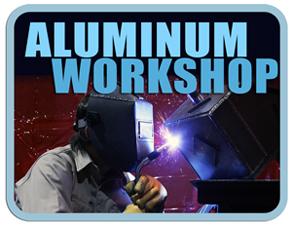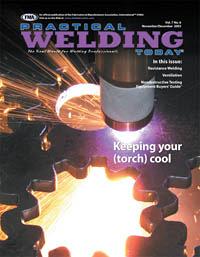President
- FMA
- The Fabricator
- FABTECH
- Canadian Metalworking
Categories
- Additive Manufacturing
- Aluminum Welding
- Arc Welding
- Assembly and Joining
- Automation and Robotics
- Bending and Forming
- Consumables
- Cutting and Weld Prep
- Electric Vehicles
- En Español
- Finishing
- Hydroforming
- Laser Cutting
- Laser Welding
- Machining
- Manufacturing Software
- Materials Handling
- Metals/Materials
- Oxyfuel Cutting
- Plasma Cutting
- Power Tools
- Punching and Other Holemaking
- Roll Forming
- Safety
- Sawing
- Shearing
- Shop Management
- Testing and Measuring
- Tube and Pipe Fabrication
- Tube and Pipe Production
- Waterjet Cutting
Industry Directory
Webcasts
Podcasts
FAB 40
Advertise
Subscribe
Account Login
Search
Aluminum Workshop: Choosing an aluminum alloy
- By Frank Armao
- January 5, 2015
- Article
- Aluminum Welding
Q: I have a project I want to build from aluminum sheet and extrusions. Some of my friends tell me to make it entirely from 6061-T6. Other tell me to use other alloys, mostly 5000 series. The project entails a lot of welding. Which alloy should I use?
A: Without knowing more details about your project, it’s hard to give a specific answer. However, I can come pretty close, so let’s try.
A lot of people choose the aluminum alloy they will use by looking at a service center catalog and then picking the strongest alloy they can find. This is a bad practice for several reasons.
First, many of the strongest aluminum alloys are unweldable. I’ve addressed this in previous columns. Specifically, you should know that most of the 2000 and 7000 series aren’t easily weldable.
Second, these catalogs usually give the unwelded mechanical properties of the alloy. As you will see, welding can degrade the strength of most aluminum alloys significantly, so the catalog may not be giving you an accurate picture of how an alloy will perform in welded fabrication.
6061-T6 is probably the most commonly used aluminum alloy in North America. It’s readily available in most product forms, including extrusions, sheet, plate bar, and tubing. It is readily weldable and relatively strong (the minimum tensile strength of 6061-T6 is 40 KSI), so it’s tempting to use it for all applications. However, it may not be the best choice in many cases. Just as in most other areas of life, there is no best choice for all applications.
Almost all extrusions are made from 6000 series alloys, and 6061 is the most popular alloy in the series. The reason for this is that the 6000 series alloys don’t work-harden quickly. This means that the extruder can run the extrusion press at high speeds and manufacture these extrusions relatively cheaply.
It also is possible to manufacture 5000 series extrusions. However, the 5000 alloys series work-hardens quickly, so the extruder must run the extrusion press much more slowly. This makes 5000 series extrusions more expensive than 6000 series extrusions. Therefore, while it’s technically possible to manufacture 5000 series extrusions, they are rarely seen.
So, if your project involves extrusions, 6061-T6 probably should be the material of choice. Because most strip and bar shapes are also extruded, 6061-T6 is also a popular choice for these forms.
OK, so why shouldn’t you use 6061-T6 for all product forms>? Simply put, other alloys will give you better welded mechanical properties. Remember, 6061 is a heat-treated alloy. The last step in producing 6061-T6 is an aging treatment at 325 to 400 degrees F. The heat of welding will overage the heat-affected zone (HAZ) of the weld. The result is that, instead of having the minimum tensile strength of 40 KSI specified for the starting material, welded joints in 6061-T6 have tensile strengths of only about 25 KSI. You lose close to 40 percent of the strength of the 6061-T6 when you weld it. Therefore, if you will weld 6061-T6 in your project, you need to base the design on this lower strength.
Now let’s discuss the 5000 series. These alloys are designed as structural sheet and plate alloys. Their primary alloying addition is between 1½ and 6 percent magnesium.
The higher the magnesium level, the stronger the alloy. None of the 5000 series alloys are heat-treatable, but they can be strengthened by cold working. Increasing the amount of cold work results in increased tensile and yield strength. The amount of cold work in an alloy is designated by an “H” temper. The H numbers are from 1 to 9, with higher numbers indicating more cold work and higher strength. The 9 designates that the alloy has been cold-worked 90 percent. A complete alloy designation for such an alloy could be 5083-H116. While all the digits in “116” have a meaning, for out purposes only look at the last of the three digits in 116. This indicates an aluminum-magnesium alloy containing 5 percent magnesium that has received 60 percent cold work. The Aluminum Association defines 44 KSI as the minimum tensile strength required for this alloy and temper.
However, when the non-heat-treatable alloys are welded, the heat of welding anneals the HAZ and softens it. The mechanical properties of the HAZ will be those of the annealed “0” temper alloy, which in this case is 40 KSI minimum.
Wait a minute. Isn’t this what happened when you used 6061-T6? How did using 5083 help?
Another choice is possible. Instead of buying 5083-H116, buy 5083-0 alloy. This has a minimum tensile strength of 40 KSI as purchased, and it still has a minimum tensile strength of 40 KSI after welding. Compare this to the 25-KSI as-welded tensile strength of 6061-T6, and you can see the advantage.
The use of 5000 series has several advantages as well. All of these alloys are weldable and much less crack-sensitive than 6061. In fact, they can be welded autogenously (without adding filler metal) using gas tungsten arc welding (GTAWA). Those of you who have tried welding 6061 alloys autogenously know that invariably they will crack.
The 5000 series alloys usually are available in thicknesses from 1/8 inch up to several inches. They also offer corrosion resistance. Some of the more common alloys in this series are 5052, 5154, 5454, 5086, 5083, and 5654, in order of increasing strength. Most of these alloys can be welded using 5356 filler metal, although you should consult a good filler metal selection chart for specific applications. They also are weldable to 6061 or any of the other 6000 series alloys using 5356 filler metal. However, they shouldn’t be welded using 4043 filler because the weld will have low toughness and ductility. The one exception to this rule is that 5052, because it contains only a small amount of magnesium, can be welded using 4043.
So what alloy should you use for your project? Use the best tool for the job. My advice is to use 6061-T6 for extrusions and barstock. Then buy a 0 temper 5000 series alloy for the sheet and plate components. You’ll achieve the best welding results and the best mechanical properties.
About the Author

Frank Armao
Aluminum Consulting Inc.
440-479-0239
About the Publication
Related Companies
subscribe now

The Welder, formerly known as Practical Welding Today, is a showcase of the real people who make the products we use and work with every day. This magazine has served the welding community in North America well for more than 20 years.
start your free subscription- Stay connected from anywhere

Easily access valuable industry resources now with full access to the digital edition of The Fabricator.

Easily access valuable industry resources now with full access to the digital edition of The Welder.

Easily access valuable industry resources now with full access to the digital edition of The Tube and Pipe Journal.
- Podcasting
- Podcast:
- The Fabricator Podcast
- Published:
- 04/16/2024
- Running Time:
- 63:29
In this episode of The Fabricator Podcast, Caleb Chamberlain, co-founder and CEO of OSH Cut, discusses his company’s...
- Industry Events
16th Annual Safety Conference
- April 30 - May 1, 2024
- Elgin,
Pipe and Tube Conference
- May 21 - 22, 2024
- Omaha, NE
World-Class Roll Forming Workshop
- June 5 - 6, 2024
- Louisville, KY
Advanced Laser Application Workshop
- June 25 - 27, 2024
- Novi, MI
































